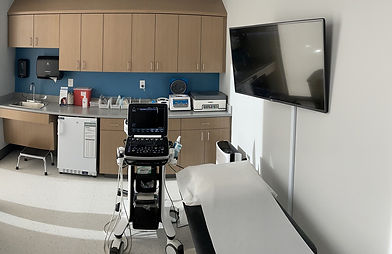Iliotibial Band (IT Band) Syndrome Treatment in Raleigh, NC
The Iliotibial Band (or tract) is a thick band of tissue that starts on the pelvis and upper thigh, passes along the outside of the knee, and attaches to the outer tibia. When the knee moves, the Iliotibial Band slides over a bony prominence on the outer knee (lateral femoral epicondyle). Iliotibial Band friction syndrome, or Iliotibial Band tendonitis, is a painful condition on the outer (lateral) aspect of the knee that is common in athletes using repetitive movement of the leg, such as cyclists and runners.
What are the Symptoms of Iliotibial Band Syndrome?
Patients with iliotibial band syndrome may have pain on the outer side of the knee, swelling at the site of injury, and a popping sensation may be felt when the knee is bent and then straightened. Pain may worsen after running, climbing stairs, or walking, but is reduced when at rest.


TREATMENT OPTIONS FOR ILIOTIBIAL BAND SYNDROME
As with most orthopedic conditions, patients will often begin with a combination of physical therapy, anti-inflammatories, ice and rest (and in some cases, steroid injections).
When these methods are no longer effective, Carolina Nonsurgical Orthopedics offers the latest in cutting-edge treatments to reduce pain and get you back to the activities you enjoy.
Some of these innovative alternatives to surgery include Orthobiologics and Regenerative Medicine treatments, such as:
-
Platelet-Rich Plasma (PRP) Injections: Use your own platelets to reduce inflammation and accelerate healing.
-
Prolotherapy: Uses dextrose (sugar water) in place of steroid to reduce pain and promote healing.
-
Shockwave: A non-invasive therapy that uses impulses to treat chronic pain and repair tissue.
See the full list of conditions and treatments offered at Carolina Nonsurgical Orthopedics.
READ MORE ABOUT IT BAND PAIN
Iliotibial Band (IT Band) syndrome is an overuse injury resulting from the inflammation of the Iliotibial band. The IT Band is a tough group of fibers that begins at the iliac crest of hip and runs along the outside of the thigh, where it attaches to the outer side of the shin bone just below the knee joint. Its function is to coordinate with the thigh muscles and provide stability for the knee joint. IT Band syndrome occurs when the iliotibial band and and the lower outside portion of the thigh bone at the knee joint rub against each other. It commonly occurs in athletes such as cyclists and runners. Iliotibial band syndrome can occur from quickly increasing distances with running or biking type activities. Other predisposing factors associated with the injury include running on uneven surfaces, wearing improper fitting shoes, uneven leg length, muscle imbalance, over pronation of the foot, and bowed legs. The average jogger strikes their foot against the ground 3,000 times per mile. This adds up to 60,000 foot impacts for every twenty miles. While running you only have one foot on the ground at a time, and when walking, 30 percent of the time both feet are on the ground. When running, the force of landing has been estimated to be about three times your body weight. This means that if you weigh 150 pounds, the force in your leg when you land is around 450 pounds. Shoe mileage should also be considered. After 500 miles most shoes retain less than 60% of their initial shock absorption capacity. When cycling, with each pedaling stroke, the iliotibial band slides over the lateral femoral epicondyle. Knee flexion and extension occur approximately 4800 times an hour (at an average cadence of 80 revolutions per minute), so the iliotibial band is susceptible to repetitive irritation. The goal of treatment is to reduce the inflammation and to relieve the pain. Some initial IT Band Syndrome treatment options may include: Rest: Allow the joint to rest to reduce the inflammation. Do not run or participate in any physical activity that may worsen the pain. Ice application: Ice packs should be applied to the site of injury which will help to diminish swelling and pain. Ice should be applied over a towel to the affected area for 15-20 minutes, four times a day for several days. Never place ice directly over the skin. Medications: Your doctor may prescribe non-steroidal anti-inflammatory drugs to reduce the pain and swelling. Foam Roller Myofascial Release: A foam roller is used underneath the tight iliotibial band to loosen it. Although this is painful, it is one of the most useful stretches to relieve the tissues. Physical therapy: Physiotherapists will teach stretching exercises and techniques to loosen the tight structures, and help strengthen the iliotibial band and the surrounding muscles. Once these treatment options are no longer effective, it's the right time to seek care from an experienced orthopedic specialist who can suggest other non-surgical and cutting-edge treatments to try. Please contact Carolina Nonsurgical Orthopedics at 919-719-2270 to schedule a consult with one of our providers.


WHY CAROLINA
NONSURGICAL ORTHOPEDICS
-
All Providers are BOARD CERTIFIED and Specially Trained in Nonsurgical Orthopedics
-
Over 50,000+ and Counting Procedures Performed
-
Procedures Performed with Ultrasound Guidance for Accuracy and Safety
-
Local and Independent Practice That is NOT a Franchise
-
Discounts for Service Members, Teachers, and Public Servants
-
Serving Raleigh Since 2013
.png)
